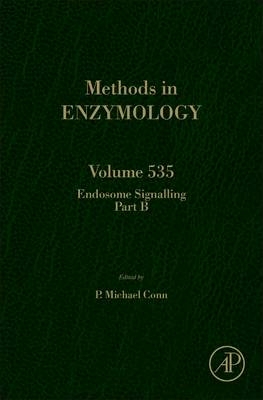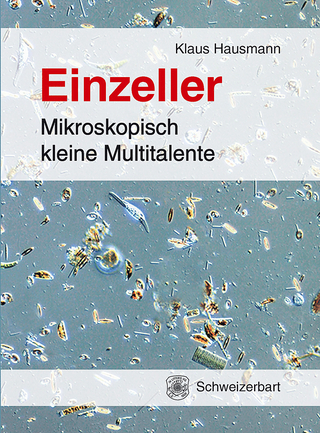
Endosome Signaling Part B
Academic Press Inc (Verlag)
978-0-12-397925-4 (ISBN)
This new volume of Methods in Enzymology continues the legacy of this premier serial with quality chapters authored by leaders in the field. This is the second of two volumes on endosome signaling and includes chapters on such topics as measurement of entry into the endosomal compartment by multi-parametric image analysis, assessment of peptide internalization and endosomal signaling, and VEGF-A in endosomal signaling.
P. Michael Conn is the Senior Vice President for Research and Associate Provost, Texas Tech Health Sciences Center. He is The Robert C. Kimbrough, Professor of Internal Medicine and Cell Biology/Biochemistry. He was previously Director of Research Advocacy and Professor of Physiology and Pharmacology, Cell Biology and Development and Obstetrics and Gynecology at Oregon Health and Science University and Senior Scientist of the Oregon National Primate Research Center (ONPRC). He served for twelve years as Special Assistant to the President and Associate Director of the ONPRC. After receiving a B.S. degree and teaching certification from the University of Michigan (1971), a M.S. from North Carolina State University (1973), and a Ph.D. degree from Baylor College of Medicine (1976), Conn did a fellowship at the NIH, then joined the faculty in the Department of Pharmacology, Duke University Medical Center where he was promoted to Associate Professor in 1982. In 1984, he became Professor and Head of Pharmacology at the University of Iowa College of Medicine, a position he held for eleven years. Conn is known for his research in the area of the cellular and molecular basis of action of gonadotropin releasing hormone action in the pituitary and therapeutic approaches that restore misfolded proteins to function. His work has led to drugs that have benefitted humans and animals. Most recently, he has identified a new class of drugs, pharmacoperones, which act by regulating the intracellular trafficking of receptors, enzymes and ion channels. He has authored or co-authored over 350 publications in this area and written or edited over 200 books, including texts in neurosciences, molecular biology and endocrinology. Conn has served as the editor of many professional journals and book series (Endocrinology, Journal of Clinical Endocrinology and Metabolism, Endocrine, Methods, Progress in Molecular Biology and Translational Science and Contemporary Endocrinology). Conn served on the National Board of Medical Examiners, including two years as chairman of the reproduction and endocrinology committee. The work of his laboratory has been recognized with a MERIT award from the NIH, the J.J. Abel Award of the American Society for Pharmacology and Experimental Therapeutics, the Weitzman, Oppenheimer and Ingbar Awards of the Endocrine Society, the National Science Medal of Mexico (the Miguel Aleman Prize) and the Stevenson Award of Canada. He is the recipient of the Oregon State Award for Discovery, the Media Award of the American College of Neuropsychopharmacology and was named a distinguished Alumnus of Baylor College of Medicine in 2012. Conn is a previous member of Council for the American Society for Cell Biology and the Endocrine Society and is a prior President of the Endocrine Society, during which time he founded the Hormone Foundation and worked with political leadership to heighten the public’s awareness of diabetes. Conn’s students and fellows have gone on to become leaders in industry and academia. He is an elected member of the Mexican Institute of Medicine and a fellow of the American Association for the Advancement of Science. He is the co-author of The Animal Research War (2008) and many articles for the public and academic community on the value of animal research and the dangers posed by animal extremism. His op/eds have appeared in The Washington Post, The LA Times, The Wall Street Journal, the Des Moines Register, and elsewhere. Conn consults with organizations that are influenced by animal extremism and with universities and companies facing challenges from these groups.
Section I. SIGNALING
1. Measurement of insulin proteolysis and assessment of insulin-mediated signaling (events) in (liver) endosomes
2. Endosomal sorting and implication for signaling
3. TGF-beta in endosomal signaling
4. Annexin A6 and endosomal signaling
5. PI-3-P in endosomal signaling
6.Endosomal signaling and cell migration
7. Measuring lipid-ginding effectors in endosomal signaling
8. Measuring role for endosomal signaling in tumorigenesis
9. Measurement of endosomal signaling in the immune system
10. Assessment of the TLR3 pathway in endosomal signaling
11. Labeling of platelet-derived growth factor to study its endocytosis and signaling
12. Endosomal signaling and oncogenesis
13. ROS - Containing endosomal compartments: implications for signaling
14. ERBIN in endosomal signaling
15. Lipid raft in endosomal signaling
16. VEGF-A in endosomal signaling
17. Assessment of peptide internalization and endosomal signaling
18. Quantitative proteomic analysis of compartmentalized signaling networks
19. Death signaling endosomes: sequential activation of Caspase-8, Caspase-9, acid sphingomyelinase and Cathepsin D in internalized TNF-receptosomes
20. Deubiquitinases and their emerging roles in cell signaling
21. NF-kB-dependent pathway in human keratinocytes
22. Endosomal signaling by the G protein coupled PARs
23. Investigating signaling consequences of GPCR trafficking in the endocytic pathway
24. MICAL-L1 in endosomal signaling
| Reihe/Serie | Methods in Enzymology |
|---|---|
| Verlagsort | San Diego |
| Sprache | englisch |
| Maße | 152 x 229 mm |
| Gewicht | 950 g |
| Themenwelt | Medizin / Pharmazie ► Medizinische Fachgebiete |
| Naturwissenschaften ► Biologie ► Zellbiologie | |
| ISBN-10 | 0-12-397925-0 / 0123979250 |
| ISBN-13 | 978-0-12-397925-4 / 9780123979254 |
| Zustand | Neuware |
| Haben Sie eine Frage zum Produkt? |
aus dem Bereich


